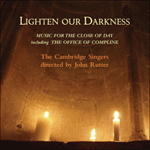Alma redemptoris mater is an antiphon of the Blessed Virgin Mary which is sung during Advent and until the Feast of the Purification. Victoria composed two settings of it, one for five voices first published in 1572, and another for eight voices dated 1581. This setting for two equal mixed-voice choirs makes clear reference to the antiphon plainsong in a striking beginning in which the three upper voices of the first choir fan out from the same note in successive entries, with the top part outlining the first phrase of the plainsong. The words ‘redemptoris mater’ are then set to a homophonic passage of wonderful sonority, which is succeeded by more contrapuntally conceived passages for ‘quae pervia caeli’ and ‘et stella maris’ with some reduction in the number of voices. The first part of the antiphon ends with a rich and rhythmically vigorous section for both choirs at the words ‘succurre cadenti surgere qui curat populo’. The Secunda Pars opens with a passage of extremely effective slow antiphonal declamation of the words ‘Tu quae genuisti’ followed by running quaver scales to express ‘natura mirante’. Soon after this Victoria uses to great effect one of his most telling harmonic devices, the introduction of a pair of chords not previously or subsequently employed in the piece, in this case a G minor and a C minor chord used at the words ‘virgo prius’ to underline the sanctity of the virginity of the Mother of God. The antiphon ends with a sustained passage of full double-choir writing of enormous richness and sonority.
from notes by Jon Dixon © 1994
Alma redemptoris mater est une antienne à la Vierge Marie qui se chante pendant l’Avent et jusqu’à la fête de la Purification. Victoria en composa deux versions, l’une pour cinq voix, qui fut d’abord publiée en 1572, l’autre pour huit voix, datée 1581. Cette composition pour deux chœurs à voix mixtes égales, fait ouvertement référence au plain-chant de l’antienne, dans un frappant début où les trois voix supérieures du premier chœur se déploient à partir de la même note en entrées successives, la partie supérieure traçant la première phrase du plain-chant. Les paroles «redemptoris mater» sont alors rendues par un passage homophonique à la sonorité merveilleuse, auquel succèdent les passages, conçus davantage pour le contrepoint, du «quae pervia caeli» et «et stella maris», avec une certaine réduction dans le nombre des voix. La première partie de l’antienne se clôt sur une section riche et rythmiquement vigoureuse pour les deux chœurs, aux paroles «succurre cadenti surgere qui curat populo». La seconde partie s’ouvre sur un passage de déclamation antiphonique, d’une lenteur puissante, des mots «Tu quae genuisti», suivi par des passages rapides de croches pour exprimer «natura mirante». Peu après, Victoria utilise avec bonheur un de ses procédés caractéristiques, l’introduction d’une paire d’accords qui n’apparaissent nulle part ailleurs dans ce morceau, dans ce cas un accord de sol mineur et de do mineur, aux mots «virgo prius», pour souligner la sainteté de la virginité de Marie. L’antienne se termine par un passage soutenu d’écriture pour le double chœur au complet, immensément riche et sonore.
extrait des notes rédigées par Jon Dixon © 1994
Français: Luisella Simpson
Alma redemptoris mater ist eine Antiphon zum Lob Marias, die von der Adventszeit bis zur Lichtmeß gesungen wird. Victoria komponierte zwei Vertonungen: eine für fünf Stimmen, die 1572 erstmals veröffentlicht wurde, und im Jahre 1581 eine für acht Stimmen. Diese Vertonung für zwei gleichgestellte Chöre mit gemischten Stimmen bezieht sich eindeutig auf die Antiphon des Cantus planus, und zwar durch einen bemerkenswerten Anfang, in dem sich die drei oberen Stimmen des ersten Chores bei aufeinanderfolgenden Eintritten von derselben Note aus auffächern und die oberste Stimme die erste Phrase des Cantus planus skizziert. Die Worte „redemptoris mater“ erklingen sodann in einer homophonen Passage von wundervoller Sonorität, auf die die mehr kontrapunktisch angelegten Passagen für „quae pervia caeli“ und „et stella maris“ mit einer Reduzierung in der Zahl der Stimmen folgen. Der erste Teil der Antiphon endet mit einem vollen und rhythmisch leidenschaftlichen Teil für beide Chöre mit den Worten „succure cadenti surgere qui curat populo“. Der Secunda Pars beginnt mit einer Passage einer überaus wirkungsvollen, langsamen antiphonen Deklamation der Worte „Tu quae genuisti“, worauf Tonleitern in Achtelnoten als Ausdruck von „natura mirante“ folgen. Kurz darauf verwendet Victoria mit großer Wirkung eines seiner effektivsten harmonischen Mittel, nämlich die Einführung von zwei Akkorden, die weder vorher noch nachher in dem Stück eingesetzt werden; in diesem Fall einen Akkord in g-Moll und einen Akkord in c-Moll zu den Worten „virgo prius“, um die Heiligkeit der Jungfräulichkeit der Mutter Gottes zu unterstreichen. Die Antiphon endet mit einer anhaltenden Passage für den kompletten Doppelchor, der in wunderbarer Vollheit und Sonorität gehalten ist.
aus dem Begleittext von Jon Dixon © 1994
Deutsch: Cornelia Schroeder


 Lighten our Darkness
Lighten our Darkness
